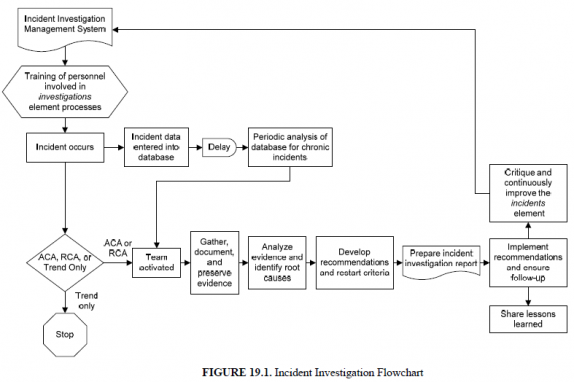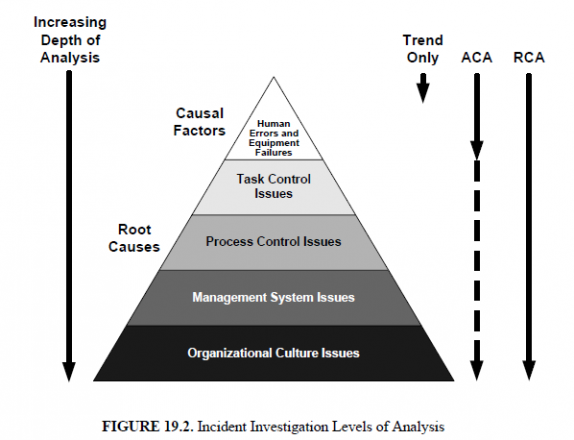ELEMENT OVERVIEW
Developing, sustaining, and enhancing the organization’s incident investigation competency is one of four elements in the RBPS pillar of learning from experience. This chapter describes the characteristics of an effective incident investigation program and how organizations might begin to enhance their own incident investigation process. Section 19.2 describes the key principles and essential features of a management system for this element. Section 19.3 lists work activities that support these essential features, and presents a range of approaches that might be appropriate for each workactivity, depending on perceived risk, resources, and organizational culture. Sections 19.4 through 19.6 include (1) ideas for improving the effectiveness of management systems and specific programs that support this element, (2) metrics that could be used to monitor this element, and (3) issues that may be appropriate for management review.
What Is It?
Incident investigation is a process for reporting, tracking, and investigating incidents that includes (1) a formal process for investigating incidents, including staffing, performing, documenting, and tracking investigations of process safety incidents and (2) the trending of incident and incident investigation data to identify recurring incidents. This process also manages the resolution and documentation of recommendations generated by the investigations. Figure 19.1 shows an overview of the incidents element activities. At some facilities, the incidents element is used to assign blame to personnel involved in an incident. This approach results in ineffective recommendations being implemented. A more effective approach is to develop recommendations that address the systemic causes of the incidents. The incidents element is not a process to assign blame, but a process to develop effective recommendations to address the underlying, system-related causes of incidents.

Why Is It Important?
Incident investigation is a way of learning from incidents that occur over the life of a facility and communicating the lessons learned to both internal personnel and other stakeholders. Depending upon the depth of the analysis, this feedback can apply to the specific incident under investigation or a group of incidents sharing similar root causes at one or more facilities. Limited investigations may only provide feedback concerning the specific incident scenario by only focusing on the causal factors (sometimes referred to as direct causes) of an incident. Addressing the causal factors can reduce the frequency of the direct causes of the incident and/or reduce the consequences of future similar incidents. Thorough investigations can provide feedback on the performance of the RBPS elements. By identifying and addressing the root causes of equipment failures and personnel errors, leveraged solutions can be developed that will reduce the frequency of entire categories of incidents and/or reduce the consequences of entire categories of incidents.
Where and When Is It Done?
Incident investigations are conducted whenever and wherever incidents occur; because performing investigations remotely is rarely effective. The investigation team is usually based near the incident scene to
allow them to more efficiently collect data by conducting interviews, gathering physical evidence, and so forth. Analysis of the root causes of incidents may occur anywhere, but being near the personnel involved in the management of the facility is preferable, as it helps foster discussions with facility personnel. Companies decide what combinations of consequences and frequencies are appropriate to trigger each type of incident feedback process: (1) formal investigation (root cause analyses [RCAs]), (2) less formal investigation (apparent cause analyses [ACAs]), and (3) trending of incident data with no immediate
investigation performed. Figure 19.2 shows the relationship of these different levels of analysis. The term apparent cause analysis was originally defined by the Department of Energy. Other terms that are typically applied to these different level of analyses include Level 1 and Level 2 analyses or basic and detailed analyses (Ref. 19.3).
Who Does It?
Personnel who have formal training in incident investigation or RCA techniques typically perform investigations and lead investigation teams. A multidisciplinary team is appropriate for incident investigations
with greater consequences and risks. An individual or a two-person investigation team may investigate incidents with lower consequences and risks. Personnel throughout the company provide assistance to the investigation team. For incidents involving significant human injuries or incidents with potential regulatory impact, the legal department will often assume overall management of the investigation. Investigation teams should engage the company’s public affairs group as the focal point for communications to the media and other external organizations (see the outreach element).

What Are the Anticipated Work Products?
The main products of an incident investigation system are: (1) basic data for all recorded incidents, including those that do not qualify for immediate investigation (trend-only incidents), (2) analysis reports for ACAs and RCAs, (3) identification of the causes of the incidents that are investigated, and (4) implemented recommendations (lessons learned and action items) that will reduce the risk of similar incidents. The results of the investigation process should be documented in a standard incident report form. Other types of work products may include up-to-date incident summary lists, action item tracking summaries, and trending data such as incident characteristics, causes, and recommendations. Data gathered during the review or generated by the investigation are usually kept at least until the action items and lessons-learned are implemented and communicated, and usually longer in accordance with company and regulatory requirements. Outputs of the incidents element should be used to facilitate the performance improvement of other elements. In most cases, recommendations aimed at the root causes of an incident will involve modifications to other RBPS elements.
How Is It Done?
A company selects its incident investigation approach and documents the approach in its investigation procedures. When an incident occurs, it is categorized, investigated, and trended according to the procedures. Data, such as interviews, paper/electronic records, physical analyses, position observations, photos, videos, and so forth, are gathered; causal factors and root causes are identified; and recommendations are made. The incident database is periodically analyzed for trends that may indicate risk-significant recurring incidents that merit formal investigation. Once identified, analyses may be performed to identify the root causes of these trends.
